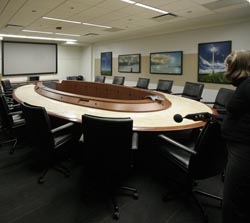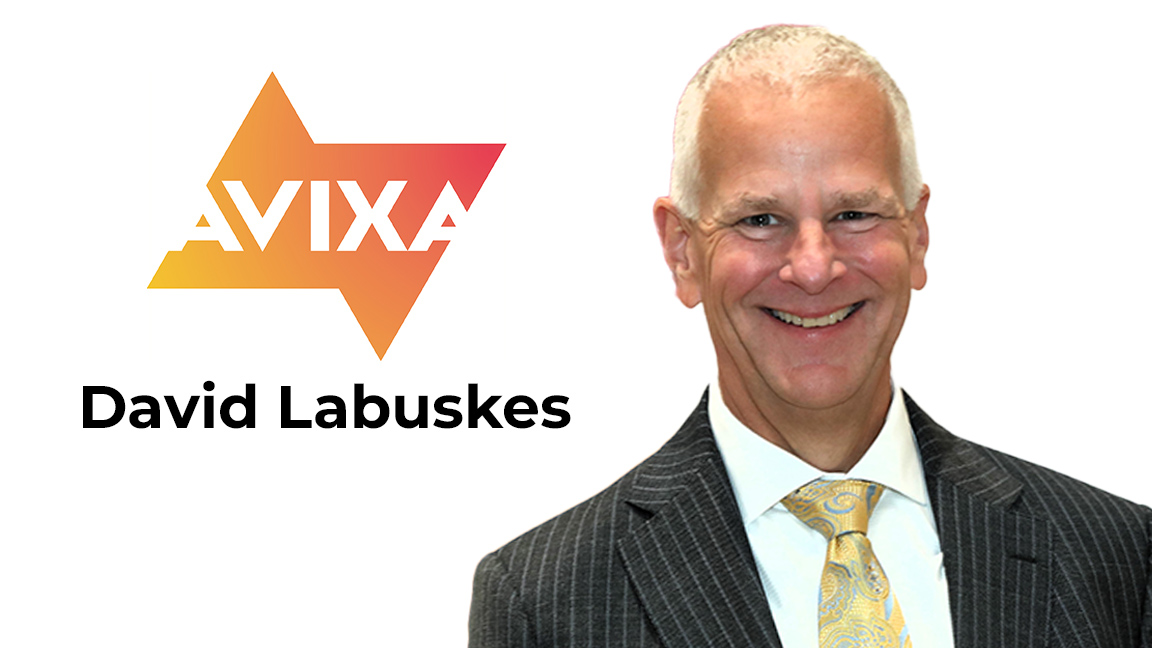Interface Ingenuity

- CHICAGO, IL-Exelon recently merged several offices into one central one location in the Chase Tower in Chicago. During the planning for the merger, the company realized that its existing boardrooms were unsatisfactory in the AV department. Exelon contacted TALASKE to join the project design team and design new AV systems for its new headquarters. Local AV systems integrator AVI-Midwest won the bid to install it.
TALASKE designed Exelon's conference rooms with customized microphone placements that took advantage of pressure points in the room to provide automatic gain control.
Exelon wanted several things for the new systems, based on previous experiences with older systems. TALASKE's David Injeski, senior video and lead AV consultant for the project, explained, "They wanted to make sure they didn't have the same problems they had before, and that the systems were integrated with the architecture and other building systems. Their existing boardroom had several complaints. With the proliferation of PDAs and Blackberries, there was a problem with the sound system picking up digital chatter from the devices. The systems had to be intuitive; they needed to be familiar and not require a lot of training. Dependability was a must and they had to be transparent. Basically they needed to get on with their business and not to be bogged down by how to work the systems."
To simplify the system, TALASKE needed to create an easy to understand interface for control. "We took all that information about what they wanted and started working backwards from the intuitive goal," Injeski said. "We thought about what was familiar to these people and figured out that most of them sit at a computer all day. They work with a standard Windows desktop and applications that have a certain look and feel across the board. We decided we'd create a graphic user interface that would be like just another application on the PC. This is not a new concept, but we decided to push it further. Instead of creating a PC version of a touch panel, we tried to emulate the look and feel of some of the Windows' utilities like, Windows Media Player. We were a bit limited in the graphics, but we made it as close as we could."
Nine months before the install, TALASKE set up a mock boardroom with all the system components and had Exelon employees come in to try out the system. Injeski recalled, "The idea was to put all the technology there and make it functional in a similar sized room. We altered the acoustics a bit, and brought in several teams from various departments, including the executives at one point. We were so close to hitting the target. The president of the company sat down then and she started clicking away." Injeski also mentioned how the interface allowed quick access to sources. "The way we designed it you were only one or two clicks away from anything you wanted to do. You didn't have to dig through nested pages or spend time learning.
We laid it out and made available things that looked like what you wanted to do. The president sat down without any instructions and started controlling the system. She remarked how quickly she could get to what she wanted. That was a great feeling, especially so early in the project. So when we started actually installing the control systems, we modeled all the interfaces after the mockup and the suggestions that were made for the systems afterward. We were 99 percent there after that, and there was little needed to polish it."
To fix the problem with the digital chatter of Blackberries, Injeski's crew evaluated the proximity of the mics in the rooms. "When we analyzed the variables, we noticed the proximity of these devices to the mics in the room," he said. "We wanted to reduce the proximity. We wanted to locate them at the ceiling, and wanted it to be transparent. We didn't want participants to be worried about being near a mic-we wanted it to be a natural thing. So we started looking at the physics involved." Injeski figured that the pressure build-up at the intersection of two planes, or a corner, or a tricorner could help them in this case. "Tandberg has been taking advantage of that phenomenon for its Audio Science mics, in which they use a Crown International PZM 6D mic. We decided on that for its performance and miniature size, it's very discrete. So we worked with the architects in all these rooms in creating an architectural feature that was isolated from the structure vibration-wise and allowed us to place a mic in this pressure zone in the corner to have a wide pickup area and a very discrete architecturally integrated listening device." It took the crew a while working internally and with the project design team. The concept was hard to deliver sometimes, people weren't interested in the physics, so TALASKE did its own drawings and forwarded them. Then when the field crew had issues with the construction of it, Injeski spent time advising them. "When all was said and done, we came out with a very successful integration of this mic. In the small videoconferencing rooms there's one mic that listens to the whole room and has great speech clarity. One of the advantages of being in a corner, a pressure zone like that, is that you get a natural acoustic gain control. It minimizes out the differences in level as you move about the room. It's a byproduct of that pressure zone."
Throughout the facility, TALASKE used Barco projectors and Da-Lite screens for videoconferencing where plasmas weren't used. Tandberg conference systems were used in videoconferencing rooms, as well as Extron switchers for video. Electro-Voice ceiling speakers were installed in the videoconferencing rooms, and several Middle Atlantic Product racks were installed to hold the customized gear.
Since all the systems are on the LAN, TALASKE was able to use Creston MP2E processors for most of the rooms. "In the boardroom we used a Pro and an AV2 in the training room. All of the display systems are HD. One of the goals that was given to us was they didn't want to be at the bleeding edge of technology, they wanted things to be proven, workable, dependable, reliable, but they also wanted to be as forward looking as possible in the design approach. We made a decision early on to implement 16x9 displays, with 1080P resolution. So at some point in the future, they will be able to install HD videoconferencing whenever they decide to get HD cameras."
A daily selection of the top stories for AV integrators, resellers and consultants. Sign up below.
